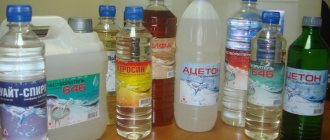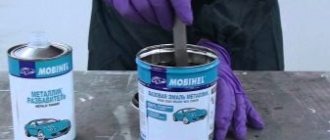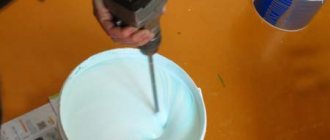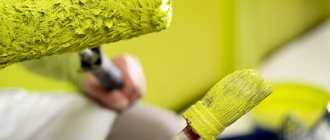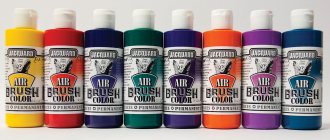Additional recommendations
Working with acrylic paints has nuances and secrets. Here are some of them:
The water must stand for 2-3 hours so that the impurities settle to the bottom. Only after this can it be used to dilute acrylic paints.
When applying the composition using a spray gun, work with branded solvents, adhering to the proportions recommended by the manufacturer. This way you will get a liquid of uniform consistency and achieve uniform coloring of the surface.
Rinse brushes and rollers thoroughly, especially if the work was performed with a highly diluted liquid. This composition is difficult to notice, so the particles remain between the villi. If you subsequently use paint of a lighter shade, the color will be spoiled.
Add the diluent to the composition in portions, thoroughly mixing the composition after each dose. To do this, use a special mixer.
It is not recommended to purchase the material “back to back” - it is advisable to leave a small amount of paint unused. This is necessary for spot restoration of the surface in case of accidental damage.
Solvent or thinner? It's decided! What and when to use?
Solvent... Thinner... What the hell difference...
(Alexander S., experienced alcohol addict)
In fact, the difference between a solvent and a thinner is quite large. It can be understood by the very name of these compounds. It will be clear to a primary school student that a solvent must dissolve and a diluent must dilute. What to dissolve and what to dilute, and how this happens, you can learn from this material.
Why are such compositions needed?
Solvents and thinners are used in painting work. Any paint is a suspension of pigments and special fillers in a binder solution. During the painting process, when the binder evaporates, a hard film is formed on the treated surface, and the surface is considered painted.
Now attention! What is the difference between a thinner and a solvent? For those uninitiated in the cult of car painters, this is difficult!
The diluent is the base substance in which the pigments float. Various substances act as paint thinners. To put it simply, a thinner is the same paint, but transparent, without a coloring pigment.
Solvent is an aggressive chemical substance that can dissolve pigment and destroy the binding elements of the coloring composition.
A friendly family of cruel solvents. Is acetone a solvent or a thinner?
White spirit, gasoline, kerosene, multicomponent solvents with numerical designations (646, 647, 650), acrylic paint solvents are all substances that can change the chemical composition of the paint used. They are sometimes divided into two categories: polar and non-polar. The former may contain water; a classic example of such a solvent is alcohol (shoutout to Alexander S, who wrote the epigraph for this article). The latter contain a mixture of hydrocarbons instead of water. A classic example of such a composition is white spirit, which is closer to gasoline than to alcohol.
In the assortment of the Avtomalar+ store you can find a full selection of solvents, from primitive BP R-647 and KDS Solvent 650, to high-quality compounds from world brands: NCPro, 3SILA. Here you will not find only acetone, since this solvent, popular in the old days, was considered dangerous in European countries due to its toxicity, volatility and increased flammability.
Family of good thinners
Thinners do not change the composition of the paint; they can make it more liquid, but ideally their composition should match the composition of the base substance. Therefore, every manufacturer of paints and varnishes recommends using thinners and paints of the same brand. If there is a difference in the chemical compositions of these substances, the evaporation process of the base substance may occur unevenly, which can lead to coating defects.
The Avtomalar+ store offers thinners from all popular brands:
- DYNA Thinner Slow;
- MOBIHEL ZS;
- 3SILA.
When using a thinner during car painting work, it is possible to achieve uniform setting of the composition applied to the surface, which means increasing the quality and service life of the entire paintwork.
Composition of solvents and thinners
The solvents contain aggressive substances that can not only soften the paint, but also burn a large hole in the plastic, and completely dissolve expanded polystyrene with the help of its lightest evaporation. As a rule, multicomponent solvents contain acetone, butyl acetate, toluene, solvent and other fun components that threaten all living things.
The composition of the thinner depends on the composition of the paint for which it is intended. In the case of alkyd enamels, alkyd varnishes are used, in the case of oil-based paint compositions, drying oil is used, etc. Even water can act as a thinner (for water-soluble acrylic paints).
How to dilute with solvents
The use of this substance depends more on the weather conditions where the repair work is being carried out. Therefore, there are no specific instructions, it all depends on the brand and manufacturer, the data is indicated on the packaging.
The use of this substance depends more on the weather conditions where the repair work is being carried out.
Correct proportions
As an example, we can take the universal 648, which is used at a temperature of 18-20 degrees. If you are going to use a regular brush or roller when painting, you can add 10% based on the volume of the can.
Regarding water:
- It is advisable to do it in the proportion recommended by the manufacturer. This is written on the packaging. The procedure is performed in a separate container to save the leftovers for next time;
- 1:1 everything is simple here. This option is the most effective and popular. The mixture is thick after mixing, which allows you to get a uniform thick coating;
- 2:1 here the builder receives the liquid composition necessary for finishing the premises. On its basis, a base coating is created; you should work with a roller. If this consistency is not suitable, then you can wait a day until the excess moisture evaporates or add a thickener. With this concentration you can get a thin layer, suitable for creating a base;
- 5:1 and 15:1 are rare in everyday life. More often used by designers when they need to find a unique tone.
Water is the cheapest but less effective option. The paint becomes watery.
If you are going to use a regular brush or roller when painting, you can add 10% based on the volume of the can.
Features of the material
Versatility is a distinctive characteristic of acrylic compositions. The products are suitable for any type of surface, except for specific plastics, which are not used in everyday life. After drying, a very thin and durable layer is formed that is not destroyed by ultraviolet radiation or mechanical stress.
Pros and cons of raw materials
The enamel is based on acrylic resin, which is obtained chemically after the breakdown of acid. To give the substance color, pigments are added to the composition. The binder holds insoluble powders together with a thin, strong film.
To impart certain characteristics or improve qualities, fillers and additives are used. Pros of acrylic paints:
- They don't burn. There are no flammable additives in the composition.
- Safe. When creating enamels, no toxic substances are used.
- Dries quickly. Already 30-60 minutes after application, a hard film forms on the surface. Complete polymerization occurs in 8-12 hours.
- Ease of use. The absence of a strong odor and uniform distribution makes working with the product easier.
The consumption of acrylic paints depends on the type of facade (plaster, porous) on which they are used. If you paint in two layers, then 170 g per square wall is enough. Manufacturers set a maximum consumption of 250-300 g per m2. The cost of building material depends on the volume and brand, so it varies from 150 to 600 rubles per kg.
The consumption of acrylic paints depends on the type of facade (plaster, porous) on which they are used. If you paint in two layers, then 170 g per square wall is enough. Manufacturers set a maximum consumption of 250-300 g per m2. The cost of building material depends on the volume and brand, so it varies from 150 to 600 rubles per kg.
Building material for the street Source budlider.com.ua
The disadvantages of paints include their dependence on temperature conditions. After drying, the acrylic enamel on the facade will no longer crack from frost, but during application the recommended requirements must be followed. Favorable conditions for painting are from +10 to +24 C. As the temperature drops, the product slowly hardens and loses its durability.
Product for facades Source kharkov.prom.ua
Main types
Facade acrylic paints are distinguished by method of use and composition. The most popular and durable varieties are those for outdoor use. After drying, a strong film is formed on the walls, resistant to moisture and physical damage. The coating does not crack from heat, frost or temperature changes.
Material for external works Source tavstroy.com.ua
